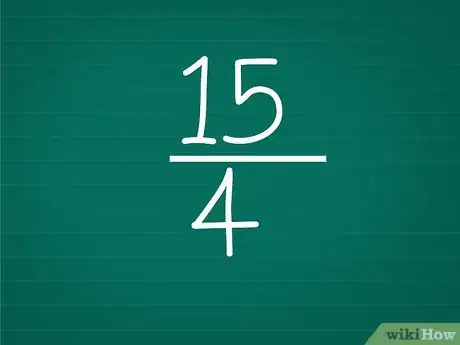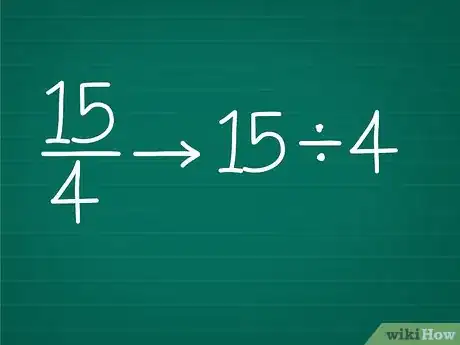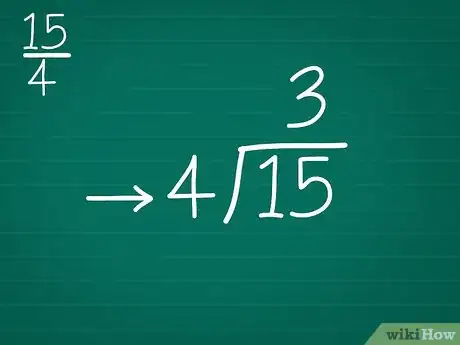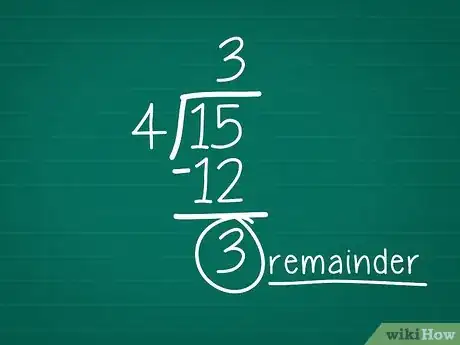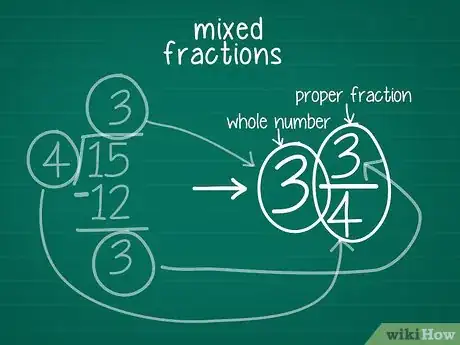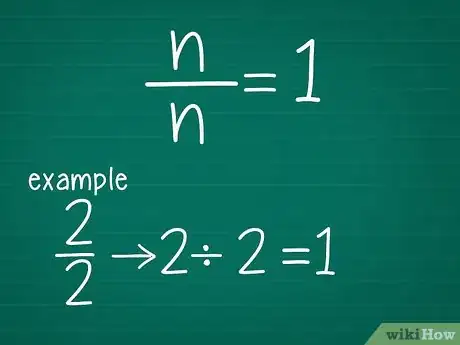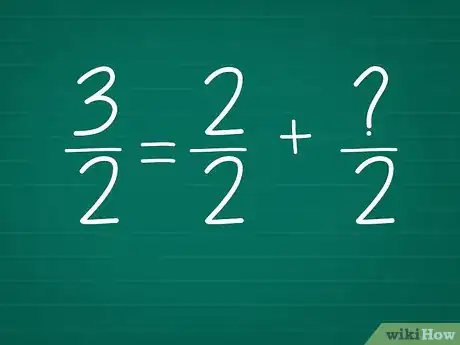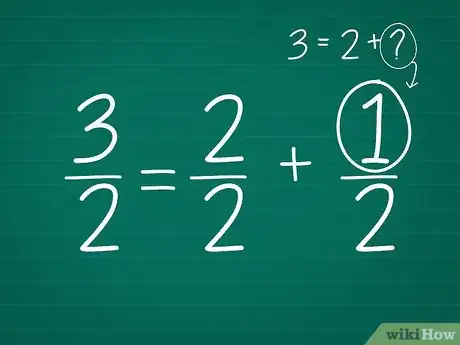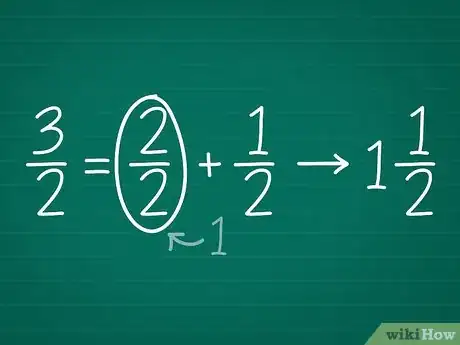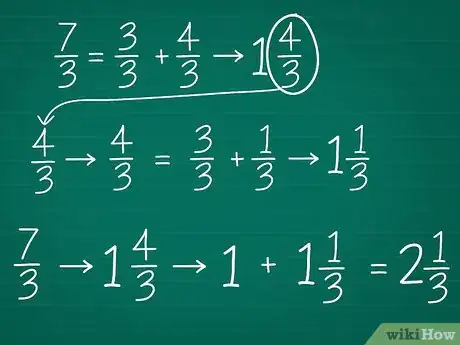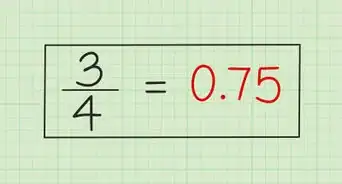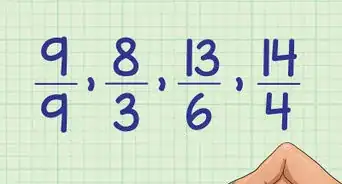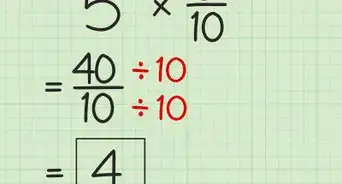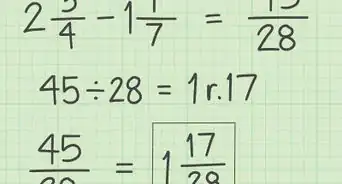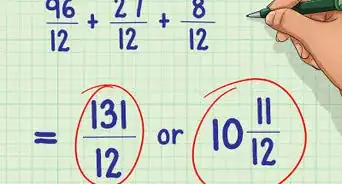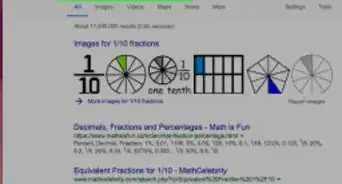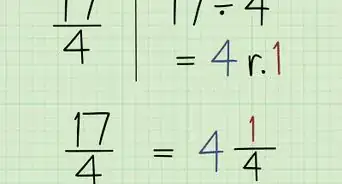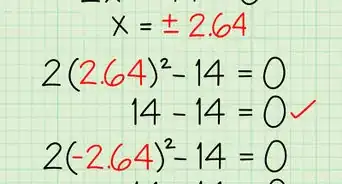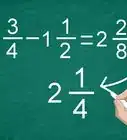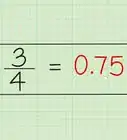wikiHow is a “wiki,” similar to Wikipedia, which means that many of our articles are co-written by multiple authors. To create this article, 16 people, some anonymous, worked to edit and improve it over time.
There are 7 references cited in this article, which can be found at the bottom of the page.
This article has been viewed 123,408 times.
Learn more...
An improper fraction is a fraction with a larger "top" than "bottom," like 5/2. Mixed numbers are a whole number and a fraction together, like 21/2. It's usually easier to imagine 21/2 pizzas than "five halves" of a pizza, so it's useful to be able to switch between them.[1] Division is the fastest way to do this, but there is an easier method included if you're having trouble with the first one.
Things You Should Know
- Use division; rewrite the improper fraction as a long division problem, then find the remainder and write the mixed number from your results.
- Without division, write down the fraction and recall all the fractions that equal 1—which is any number divided by itself.
- Split the fraction into two parts; find the second part and then simplify the fraction, repeating until you have the right number.
Steps
Using Division
-
1Start with an improper fraction. We'll use 15/4 for our example. This is an improper fraction because the numerator, 15, is greater than the denominator, 4.
- If you're not comfortable with fractions or division yet, start with the example below instead.
-
2Rewrite it as a division problem. Write the fraction as a long division problem.[2] Always write the numerator divided by the denominator. In our example, this is 15 ÷ 4.Advertisement
-
3Begin solving the division problem. Review long division first if you're not sure what to do.[3] This example will be easier to follow if you write out the long division problem as you read it:
- Compare 4 to the first digit, 1. 4 doesn't go into 1, so we need to include the next digit.
- Compare 4 to the first two digits, 15. How many times does 4 go into 15? If you're not sure, guess and see if you're right using multiplication.
- The answer is 3, so write 3 on the answer line, above the 5.
-
4Find the remainder. Unless the numbers divide perfectly, there will be a remainder left over. Here's how to find the remainder in a long division problem:[4]
- Multiply the answer by the divisor (the number on the left). In our example, that's 3 x 4.
- Write the result underneath the dividend (the number underneath the division bracket). In our example, 3 x 4 = 12, so write 12 underneath the 15.
- Subtract the result from the dividend: 15 - 12 = 3. This is the remainder
-
5Write the mixed number using your results. A mixed number is a whole number, plus a proper fraction. After solving your division problem, you have everything you need to write this mixed number:[5]
- The whole number is your answer to the division problem. In this case, that's 3.
- The numerator of the fraction is your remainder. In this case, that's also 3.
- The denominator of the fraction is the same as the denominator in the original fraction. In this case, that's 4.
- Write this as one mixed number: 33/4.
Without Using Division
-
1Write down the fraction. An improper fraction is any fraction with a top number larger than the bottom number. For example, 3/2 is an improper fraction, because 3 is larger than 2.
- The top number of a fraction is called the numerator. The bottom number is called the denominator.
- This method will take a long time for large fractions. If the numerator is much larger than the bottom number, the division method above is much faster.
-
2Remember which fractions equal one. Did you know that 2 ÷ 2 = 1? Or that 4 ÷ 4 = 1? In fact, any number divided by itself equals one. Fractions are exactly the same.[6]
- 2/2 = 1, and 4/4 = 1, and even 397/397 equals 1!
-
3Split the fraction into two parts. That sounded like an easy way to turn a fraction into a whole number. Let's see if we can do that for part of our improper fraction:
- For 3/2, the denominator (lower number) is 2.
- 2/2 is an easy fraction to simplify, because the top and bottom numbers are the same. We want to take this out of the larger fraction, and find out what we have left behind.
- Write this down: 3/2 = 2/2 + ?/2.
-
4Find the second part. How do we turn that question mark into a number? If you don't know how to add and subtract fractions, don't worry. When the denominators (bottom numbers) are the same, we can ignore them and turn the problem into ordinary addition.[7] Here's a step by step guide for our example, 3/2 = 2/2 + ?/2:
- Look at just the numerators (top numbers). They say 3 = 2 + "?". what number can we write instead of that question mark to solve the problem? What number can you add to 2 to get 3?
- The answer is 1, because 3 = 2 + 1.
- When you get the answer, write the equation again, including the denominators: 3/2 = 2/2 + 1/2.
-
5Simplify the fraction. Now we know our improper fraction is the same as 2/2 + 1/2. We also know that 2/2 = 1, just like any fraction with the same top and bottom number. That means you can cross out 2/2, and write 1 instead. Now we have 1 + 1/2, which is a mixed number! For this example, the problem is solved.[8]
- Once you've found the solution, you don't need to write the + symbol anymore. Just write 11/2.
- A mixed number is a whole number plus a proper fraction.[9]
-
6Repeat these instructions if the fraction is still improper. Sometimes, the fraction part of your answer will still be improper, with a numerator larger than the denominator. In this case, you can start again with that fraction, turning it into another mixed number. Don't forget to add the "1" back when you're done. Here's an example, turning 7/3 into a mixed fraction:[10]
- 7/3 = 3/3 + ?/3
- 7 = 3 + ?
- 7 = 3 + 4
- 7/3 = 3/3 + 4/3
- 7/3 = 1 + 4/3
- That fraction is improper, so ignore the 1 for now and do the same thing: 4/3 = 3/3 + ?/3
- 4 = 3 + ?
- 4 = 3 + 1
- 4/3 = 3/3 + 1/3
- 4/3 = 1 + 1/3
- That fraction is proper, so we're done. Remember to add the 1 we ignored earlier: 1 + 1 + 1/3 = 21/3.
Community Q&A
-
QuestionHow can I change 12/3 to a whole number?
 ChristopherTop AnswererDivide 12 by 3 and you'll find that the answer is 4. When you see that type of slash, think the division sign instead.
ChristopherTop AnswererDivide 12 by 3 and you'll find that the answer is 4. When you see that type of slash, think the division sign instead. -
QuestionHow do I convert 9/8 to a mixed number?
 Community AnswerSee how many times 8 goes into 9, which is once. This number is your whole number, with a remainder of 1; therefore. the mixed number fraction would be 1 and 1/8.
Community AnswerSee how many times 8 goes into 9, which is once. This number is your whole number, with a remainder of 1; therefore. the mixed number fraction would be 1 and 1/8. -
QuestionHow do I write 7 3/4 as an improper fraction?
 ChristopherTop AnswererTo convert a mixed number into an improper fraction, multiply the whole number by the denominator, then add the numerator. Place this result over the denominator to get your improper fraction. So, to convert 7 3/4: 7*4 = 28. 28 + 3 = 31. 31/4 is your answer.
ChristopherTop AnswererTo convert a mixed number into an improper fraction, multiply the whole number by the denominator, then add the numerator. Place this result over the denominator to get your improper fraction. So, to convert 7 3/4: 7*4 = 28. 28 + 3 = 31. 31/4 is your answer.
References
- ↑ https://www.mathsisfun.com/improper-fractions.html
- ↑ http://www.mathgoodies.com/lessons/fractions/fractions_to_mixed.html
- ↑ https://www.mathgoodies.com/lessons/fractions/fractions_to_mixed
- ↑ https://www.cuemath.com/numbers/improper-fraction-to-mixed-number/
- ↑ https://www.mathsisfun.com/mixed-fractions.html
- ↑ https://www.khanacademy.org/math/cc-fourth-grade-math/imp-fractions-2/imp-mixed-numbers/a/mixed-numbers-and-improper-fractions-review
- ↑ https://www.khanacademy.org/math/cc-fourth-grade-math/imp-fractions-2/imp-mixed-numbers/a/mixed-numbers-and-improper-fractions-review
- ↑ https://www.calculatorsoup.com/calculators/math/fractionssimplify.php
- ↑ https://www.mathsisfun.com/mixed-fractions.html
About This Article
To turn an improper fraction into a mixed number, just divide the numerator by the denominator. For example, if your improper fraction is 15/4, you would divide 15 by 4 to get 3.75. Just remember to write your answer in mixed-number format, using the original denominator for the fraction. So in this case, your improper fraction would be the mixed number 3¾. To learn how to turn an improper fraction into a mixed number without using division, scroll down!
